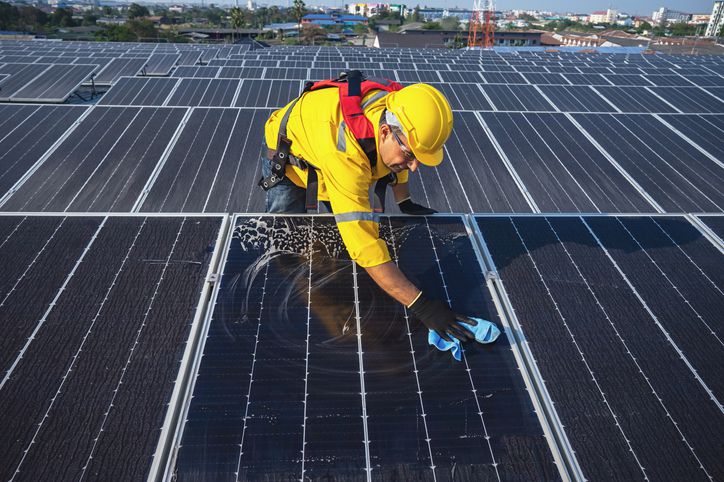Keeping your solar panels clean is key to ensuring they operate at their highest efficiency. Over time, dirt, dust, and debris can build up, blocking sunlight and reducing energy output. Regular cleaning can help maintain their performance and prolong their lifespan.
In this article, we’ll walk you through the best methods for cleaning your solar panels safely and effectively, so you can make the most of your renewable energy system.
Why Cleaning Solar Panels Matters
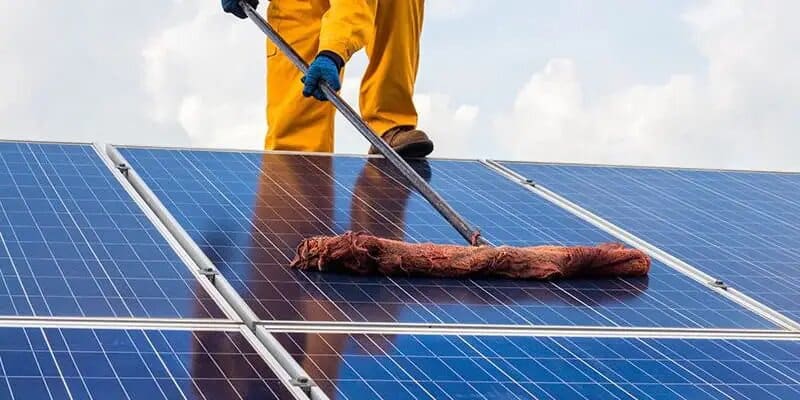
Think of your solar panels as the engine of your clean energy system. When panels are dirty, their ability to produce electricity decreases. Dust, pollen, bird droppings, and other debris can block sunlight from reaching the panels, reducing efficiency by several percentage points. Regular cleaning ensures your system operates at its best, maximizing energy output and saving you money in the long run.
Seasonal Challenges in Early Spring
Spring is a beautiful season, but it presents unique challenges for solar panel owners. In areas like Southern California, pollen levels peak in early spring. That sticky yellow dust clings to everything, including solar panels, creating a layer that blocks sunlight. Homeowners often notice a dip in their system’s energy production during this time.
You might wonder, “Is it worth cleaning them?” The answer is a resounding yes. Regular cleaning can boost energy production by 3-5%, depending on how dirty the panels are. Over time, that’s a difference you’ll feel in your energy savings.
By the way, if you’re curious about how your solar panels could be powering other aspects of your home, check out this guide on How many solar panels to charge a Tesla Model 3. It’s a great way to see how efficient your solar system can be for other needs!
Common Questions About Cleaning Solar Panels
If you’ve ever wondered, “What’s the best way to clean solar panels?” or “Can I use soap to clean them?” — you’re not alone. These are some of the most common questions users have.
In the following, we’ll address these concerns step by step, helping you clean your panels the right way and keep them performing at their best. Let’s break down the answers step by step to ensure you’re cleaning your panels properly.
Precautions Before Cleaning Solar Panels
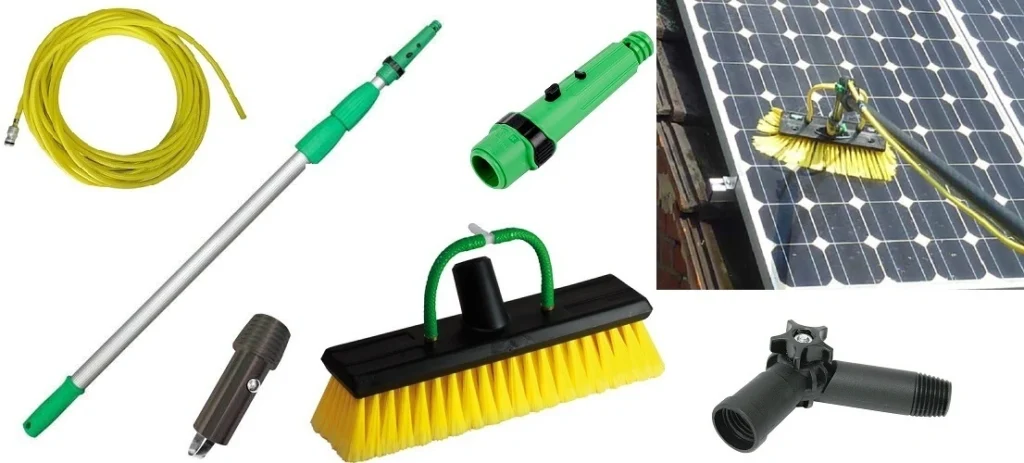
To ensure your solar panels maintain optimal performance, regular cleaning is essential. However, before you start, there are a few key precautions to keep in mind to avoid damaging the panels.
1. Temperature: Choose the Right Cleaning Time
Solar panels can get very hot during the day, with surface temperatures reaching up to 120°F (around 49°C) or higher. Cleaning them under these conditions could cause thermal shock, leading to cracked glass. Therefore, it’s best to clean your panels during the cooler hours of the day, such as in the early morning or evening.
- Best Cleaning Time: Early morning or evening when the sun is not directly overhead and the panel surface is cooler, making cleaning safer.
- Avoid Sudden Temperature Changes: Do not spray cold water on hot panels. Sudden temperature changes can cause the panels to crack, much like pouring cold water on a hot car windshield.
2. Water Selection: Use Plain Tap Water
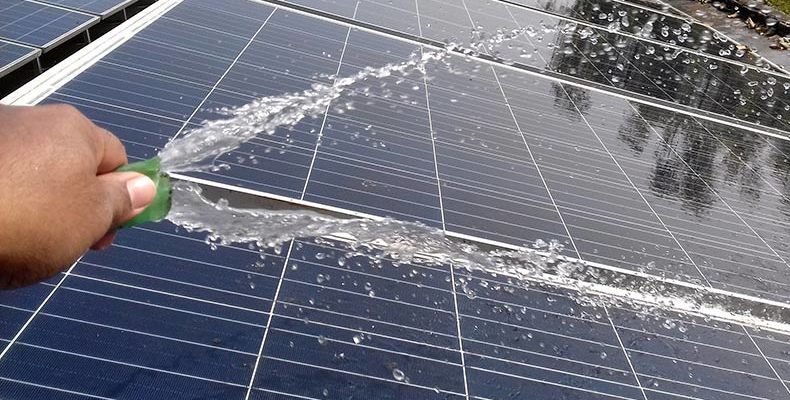
When cleaning your solar panels, there’s no need for special cleaning solutions. Plain tap water is the safest and most effective cleaner. Avoid using soap, chemical cleaners, or any harsh solutions, as they can damage the protective coating on the panels, reduce efficiency, and shorten their lifespan.
- Recommended Water Source: Plain tap water
- Avoid Using: Soap, cleaning agents, or any chemical-based products
- Mineral Stains: If you live in a hard water area, you may notice mineral stains on the panels once the water dries. To prevent this, it’s recommended to use a rubber squeegee to dry the surface after rinsing.
3. Choosing the Right Cleaning Tools
When cleaning your solar panels, it’s important to use tools that are gentle on the glass to avoid scratches or damage. Here are some recommended tools:
- Garden Hose: Ideal for washing the surface of the panels. A garden hose provides enough water pressure to easily remove dust and loose dirt.
- Soft-Bristle Brush: Perfect for stubborn stains like bird droppings, tree sap, or pollen. Be sure to use a soft-bristle brush and avoid hard or abrasive brushes, as these can scratch the glass.
- Avoid Pressure Washers: Although pressure washers may seem effective, the high water pressure can damage the panel surface and cause micro-cracks, reducing the efficiency of your solar panels.
Once you’ve taken these precautions, follow the steps below to clean your solar panels and keep them performing at their best.
How to Clean Solar Panels: Detailed Steps
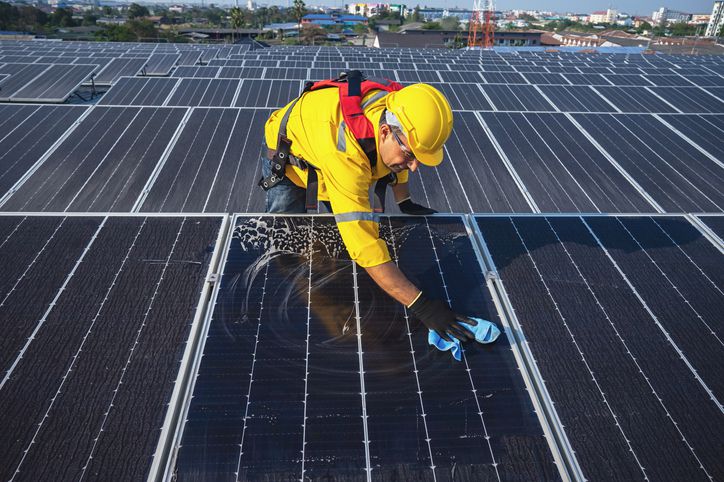
Here are the detailed steps to help you clean your solar panels safely and effectively.
Step 1: Rinse the Panels
Use a garden hose to gently rinse the solar panels, removing most of the dust and loose dirt from the surface. Ensure the water pressure is moderate and not too high, as excessive pressure can damage the panels. This step will remove most of the loose dirt easily.
Tip: If there’s a lot of dust on the panels, start cleaning from the top to prevent the dirt from falling onto other areas you’ve already cleaned.
Step 2: Use a Soft-Bristle Brush for Stubborn Stains
For tough stains such as bird droppings, tree sap, or pollen, gently scrub them using a soft-bristle brush. Make sure to apply light pressure to avoid scratching the panels. You can use lukewarm water to help soften the stubborn stains.
Tip: Use a specialized solar panel cleaning brush or a pool cleaning brush, as these are designed for delicate surfaces and won’t damage the glass.
Step 3: Rinse and Inspect the Panels
After scrubbing off the stubborn stains, rinse the panels again with the garden hose to ensure all cleaning agents and dirt are completely washed off. Inspect the surface of the panels for any remaining spots or water stains. If you notice mineral water spots, use a rubber squeegee to dry the panels quickly.
Tip: Make sure you don’t miss any dirt, especially along the edges or corners of the panels, to avoid leaving streaks or marks that could affect the appearance.
Step 4: Dry the Panels
If you live in a hard water area, mineral spots may form after the water dries. To avoid this, quickly dry the panels using a rubber squeegee after rinsing. This will not only prevent water stains but also keep the surface shiny for optimal performance.
Tip: When drying, keep the rubber squeegee parallel to the panel surface and avoid applying too much pressure.
Finally, regularly check the cleanliness of the solar panels to ensure there are no scratches or damage. If you notice any issues with the panel surface, consider having it inspected by a professional.
How Often Should You Clean Your Panels?
“Do I need to clean my panels every month?” Mike gets this question a lot. For many homeowners, once a year is sufficient. However, your location and environment play a big role.
If you live near the coast or in a dusty area, you may need to clean them more frequently. Spring is the ideal time for cleaning because it prepares your system for the high-production months of summer.
Real Results from Cleaning Solar Panels
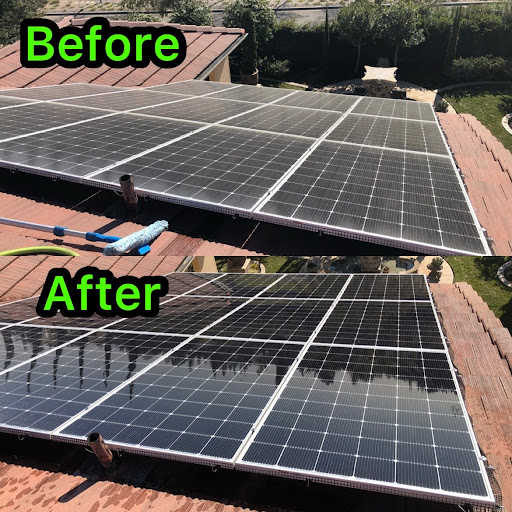
According to several case studies, many homeowners have reported a 3-5% increase in system efficiency after cleaning their solar panels. While the results may vary depending on the level of dirt buildup, this improvement highlights the importance of regular cleaning and maintenance.
After cleaning, homeowners not only benefit from more efficient energy use but also enjoy lower electricity bills.
Conclusion
Cleaning your solar panels doesn’t have to be complicated. With a little attention to temperature, tools, and water type, you can keep your system running smoothly and efficiently. Stick to the basics: use cool tap water, avoid harsh chemicals, and clean gently with a soft brush or a garden hose. For those looking for a spotless finish, a simple squeegee does the trick.
Want to learn more about solar panel maintenance or have additional questions? You can always reach out to MOREDAY professionals at info@moreday.com. A clean panel isn’t just about appearances—it’s about maximizing your energy savings year-round. Happy cleaning!
FAQ
1. Why You Shouldn’t Use a Pressure Washer
Pressure washers may seem like an efficient option for cleaning, but they can do more harm than good. High-pressure water can damage the panel’s surface or even cause microcracks, reducing energy production.
Stick to a regular garden hose for gentle cleaning. It provides enough pressure to rinse away dirt without risking damage.
2. Why Temperature Matters When Cleaning Solar Panels?
Solar panels can become very hot during the day, with temperatures often reaching 120°F (49°C) or higher. Cleaning them when they’re this hot increases the risk of damage. It’s best to clean the panels in the early morning when the surface is cooler and the sun is not directly overhead. The cooler environment makes cleaning safer and provides you with more comfortable working conditions.
If you’ve ever noticed how pouring cold water on a hot car windshield can cause it to crack, you understand the importance of timing. The same principle applies to your solar panels.
Click to learn: How to Install an Automatic Transfer Switch

